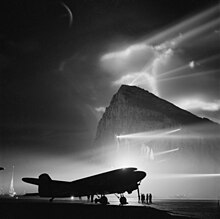Its strategic value increased with the opening of the Suez Canal, as it lay on the sea route between the UK and the British Empire east of Suez. In the later 19th century, major investments were made to improve the fortifications and the port.
Contemporary history:
During the Second World War, most of Gibraltar’s civilian population was evacuated, mainly to London, but also to parts of Morocco and Madeira and to Gibraltar Camp in Jamaica. The Rock was strengthened as a fortress. On 18 July 1940, the Vichy French air force attacked Gibraltar in retaliation for the British bombing of the Vichy navy. The naval base and the ships based there played a key role in the provisioning and supply of the island of Malta during its long siege. As well as frequent short runs, known as “Club Runs”, towards Malta to fly off aircraft reinforcements (initially Hurricanes, but later, notably from the USN aircraft carrier Wasp, Spitfires), the critical Operation Pedestal convoy was run from Gibraltar in August 1942. This resupplied the island at a critical time in the face of concentrated air attacks from German and Italian forces. Spanish dictator Francisco Franco‘s reluctance to allow the German Army onto Spanish soil frustrated a German plan to capture the Rock, codenamed Operation Felix.
In the 1950s, Franco renewed Spain’s claim to sovereignty over Gibraltar and restricted movement between Gibraltar and Spain. Gibraltarians voted overwhelmingly to remain under British sovereignty in the 1967 Gibraltar sovereignty referendum, which led to the passing of the Gibraltar Constitution Order in 1969. In response, Spain completely closed the border with Gibraltar and severed all communication links. The border with Spain was partially reopened in 1982 and fully reopened in 1985 before Spain’s accession to the European Community.
In the early 2000s, Britain and Spain were in negotiations over a potential agreement that would see them sharing sovereignty over Gibraltar. The government of Gibraltar organized a referendum on the plan, and 99% of the population voted to reject it. In 2008, the British government committed to respecting the Gibraltarians’ wishes. A new Constitution Order was approved in referendum in 2006. A process of tripartite negotiations started in 2006 between Spain, Gibraltar and the UK, ending some restrictions and dealing with disputes in some specific areas such as air movements, customs procedures, telecommunications, pensions and cultural exchange.
In the British referendum on membership of the European Union 96% of Gibraltarians voted to remain on an 84% turnout. Spain renewed calls for joint Spanish–British control of the peninsula; these were strongly rebuffed by Gibraltar’s Chief Minister. On 18 October 2018, however, Spain seemed to have reached an agreement with the United Kingdom in relation to its objections to Gibraltar leaving the EU with the UK, with Spain’s prime minister Pedro Sánchez stating, “Gibraltar will no longer be a problem in arriving at a Brexit deal.”
On 31 January 2020, the UK left the European Union and consequently so did Gibraltar. Under the terms of the transition phase in the Brexit withdrawal agreement, Gibraltar’s relationship with the EU continued unchanged until the end of 2020 when it was replaced by the EU–UK Trade and Cooperation Agreement. On 31 December 2020, the UK and Spain agreed in principle on a basis for the EU and the UK to negotiate an agreement through which Gibraltar would participate in the Schengen Area, to avoid a hard border with Spain. The arrangements have not entered into force, but both sides aim to keep delays at the border at a minimum in the meantime.
Geography:
Gibraltar’s territory covers 6.7 square kilometres (2.6 sq mi) and shares a 1.2-kilometre (0.75 mi) land border with Spain. The town of La Línea de la Concepción, a municipality of the province of Cádiz, lies on the Spanish side of the border. The Spanish hinterland forms the comarca of Campo de Gibraltar (literally “Countryside of Gibraltar”). The shoreline measures 12 kilometers (7.5 mi) in length. There are two coasts (“Sides”) of Gibraltar: the East Side, which contains the settlements of Sandy Bay and Catalan Bay; and the Westside, where the vast majority of the population lives. Gibraltar has no administrative divisions but is divided into seven Major Residential Areas.



